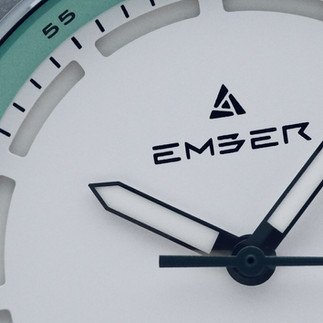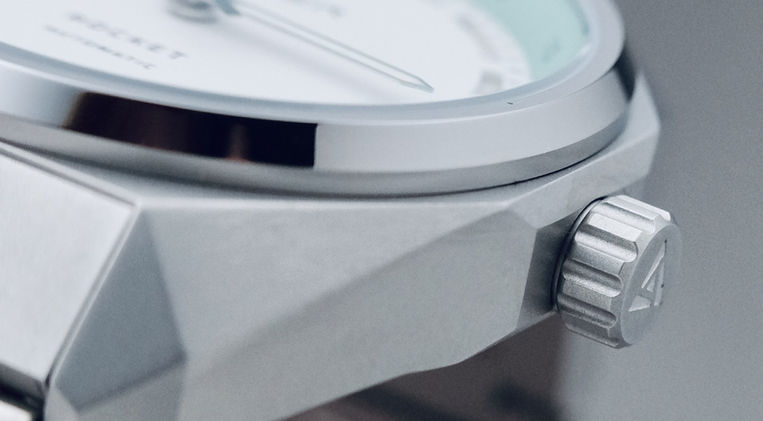Ember Watch Co. Rocket Glacial White
Marking a New Type of Watch Design
We typically slide watches into one of a few traditional categories—field, GMT, diver, dress, chronograph—based on common technical and visual characteristics they share. But doing so seems a bit reductive at times because a field watch can be more than a utilitarian, time-only timekeeping device. It can be an aesthetic expression in and of itself that goes beyond its traditional intended purpose, without ever going into the bizarre and otherworldly realms of horology. Since watches are both machines and objects, they can be sub-categorized according to unique design characteristics—just like they are genre of visual arts. For example, RZE, Circula, and Namica design cases which share common visual elements: bead-blasted treatments, angular cases (mostly) devoid of rounded corners, and wide chamfers which spill over the flanks. Are these just fields or GMTs or divers or something more? Futuristic sports watches? Dystopian tool watches?
Who knows what to call them but they are much more than a complication or a number of hands.
So is today’s protagonist, the Ember Watch Co. Rocket Glacial White. It is impossible to put this watch into any of the traditional categories because there is nothing traditional about it. It’s a watch—obviously—but it’s also the mechanical and visual expression of a watch enthusiast and entrepreneur, John Glinister, the summary of his experiences, successes and setbacks, good ideas and bad ones. It took time for John to fine-tune the design of the Rocket and to set in stone the values and mission of his brand. And all of this time spent finding ways to contribute to the watch world has resulted in a first collection which is unique, now a bit classic (referring back again to RZE and Namica,) but one which is resolutely contemporary, modern, and relevant. And the latter is true on two accounts: its incredible spec-and-design-to-dollar ratio and its singular identity.

Specifications
To put all watches on a common plane, it is necessary to first look at their specifications. No, the Rocket is not made of titanium but of bead-blasted 316L stainless steel which is endowed with a pronounced matte finish—except for the exceptionally polished upper section of the fixed bezel. (I’m writing this review on a sunny day and the bezel is projecting rays of sunlight everywhere in my office.) This juxtaposition of a matte case with a polished bezel is rare but now new, for example, as we saw it in my recent review of the Circula ProFlight. (See what I’m talking about?) Polishing this particular part of the case is interesting to me as it demonstrates what is now possible to do with watch cases, what was not possible to do just a year ago, and what mainstream brands don’t even bother exploring. But I digress and I don’t at the same time.

This non-titanium ensemble has contemporary dimensions which I find to be common for this type of case design: 40mm in diameter, 47mm lug-to-lug, 12mm thick and a 20mm lug width. On my 6.50”/16.5cm wrist, the Ember Rocket commands the right amount of wrist presence which is what watches of this kind generally do. Although I cannot yet precisely categorize the Rocket, it is so far a tool watch. What also makes me say so is the 100 meters of water resistance (screw-down crown and case-back,) the reliable Seiko NH38A caliber (3Hz/41 hours of power reserve,) the flat sapphire crystal, and the copious amounts of lume provided by a proper sandwich dial construction where a lume disc resides underneath the main dial element. The Rocket can be had on a bead-blasted H-Link bracelet, a FKM rubber strap, or a leather strap.

All three options of fastening systems are excellent and the bracelet, which is the latest addition, comes with all the bells and whistles we watch nerds relish: quick-release spring-bars, screwed links, male end-links, double-pusher deployant clasp with a built-in on-the-fly micro-adjustment system of the ratcheting type. Indeed, as found on a proper tool watch.

Design
While we are still looking for ways to define what the Ember Rocket is, studying its design might give us some clues, starting with the case. As we already know, the Rocket has contemporary dimensions for a three-hander (long gone are the days when it was common for time-only watches to measure 35mm in diameter or less,) which means, by default, it is visually muscular. An impression which is reinforced by the indeed wide and angular surfaces, the absence of curved or rounded parts, where we find multiple facets coming together in sharp corners. In some ways, the case of the Ember Rocket reminds me of Seiko’s Grammar of Design which required “that all surfaces and angles from the case, dial, hands, and indices had to be flat and geometrically perfect to best reflect light.” (Check out this article to learn more.) Though on the Rocket some of the surfaces are shorter or wider than others, but the idea is here.

In other words, the case is made of a series of flat surfaces of various dimensions and angles, where the most noticeable one is the section which would, traditionally, be the chamfers. The latter sit in-between the case flanks and upper sections of the mid-case, and are prolonged by the lugs which are made out of three facets. The crown (5.7mm in diameter) appears rather small compared to the rest of the case which is a good thing as it guarantees all-day wearing comfort. And where the crown sits and on the opposite side of the case, the massive chamfers come together to form two other chamfers which create a perfect case symmetry as well as diversifying the intense visual spectacle of the case. The case is indeed thoughtfully designed and executed and makes up an integral part of the overall design identity of the Rocket.

The dial is yet something else. It looks good nestled into the case but looks very different from it at the same time. While the case is all about facets and sharp angles, the dial is all about curves. (Well, mostly.) The sandwich construction means the space between each hour marker is occupied by curved apertures making it possible for large sections of the lumed disc (a disc made of SuperLuminova BGW9) to show through so that nighttime legibility is excellent. These spaces are actually so large that it’s easy to see the matte texture of the lume compound which is quite neat. And daytime legibility is guaranteed by the narrow passages formed in-between the hollow sections of the main plate as they are aligned with the minute markers and the 5-minute increments painted in black on the angled rehaut. The hands are standard affair for being polished and of the sign-post design variant.

The Heart of the Matter
Five minutes into the review and I’m still not sure how to best define and categorize what the Ember Rocket is. And I’m starting to believe it’s pointless to do so for two reasons. One, because “being its own thing” is just as effective in describing the Rocket as it is to pigeonhole this model into an already or yet-to-be defined category. Two, because I’m working hard to not to be like the myriad of self-proclaimed watch experts who get an ego rush by coining terms. (Though I love you folks!) However, I feel comfortable saying that this model belongs to a sub-category of watches which were created and nurtured by micro and independent brands in the past five years or so. As indeed the case of the Rocket makes me think of a few other models I’ve reviewed in the past few years, belonging to a style of case design which is becoming more common nowadays.

Which only means that this model inscribes itself within a current of horological design which is popular today, just the same way two French painters from different parts of France could paint in the impressionist style in the 19th century.

So where does that leave us? Well, we could say that the Ember Rocket is a de facto contemporary and modern watch for having this particular type of case design and for being well spec’ed. The specifications have to be put within the context of price and of the current state of the independent watch market—$473 USD for a Seiko caliber, sapphire crystal, excellent lume, 100 meters of water resistance, a good bracelet, and overall good manufacturing quality. That’s good for what you get and on this fact alone means the Rocket is very competitive. But more importantly, this model is the symbol of what indie brands do best—being creative and bold—and what is best about the watch community—being inspired by and supporting each other. What brands, which preceded Ember, did was to open new avenues for watch design. And John built upon this to bring about his own vision for what a contemporary sports watch is.

And I for one will say he did an excellent job and I love the fact that he embraced the visual
codes of contemporary watch design. John indeed managed to find ways to slide the Rocket into a niche segment of micro/indie horological design whilst stamping his own signature onto the dial. It's akin to revisiting something which already exists, contributing to a new way of designing watches, paying homage to and supporting the few watch brands which do things properly and authentically, signaling that the Ember Watch Company is a brand that is modern and active. I hope any of this makes sense.

Conclusion
To finish this long-winded review with helpful pieces of information, you should know that the Rocket exists in four versions—Glacial White, Midnight Neon, Skyline Pink, and Sunset Orange. The aforementioned price of $473 USD is for the watch on the leather and FKM rubber strap, as the bracelet will cost a tad more—$579 USD. Moreover, Ember will be officially launching the bracelet on March 31, 2025, and for seven days will be offering the Rocket on the bracelet at the discounted price of £422/$544 USD. Lastly, if you already have a Rocket you can buy the bracelet separately for £63/$81 USD discounted and £90/$116 USD full retail. Oh, and all models are readily available for purchase on the brand’s website. So that’s all folks!
Thanks for reading.








































